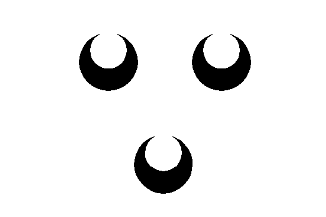 Shipmate Flagchart : http://www.shipmate.nl/flags.htm
Shipmate Flagchart : http://www.shipmate.nl/flags.htm
adopted 11 Sep 1956; design: unknown

Last modified: 2005-06-25 by jarig bakker
Keywords: oosterhout |
Links: FOTW homepage |
search |
disclaimer and copyright |
write us |
mirrors
 Shipmate Flagchart : http://www.shipmate.nl/flags.htm
Shipmate Flagchart : http://www.shipmate.nl/flags.htm
adopted 11 Sep 1956; design: unknown
Flag: white with three lying black crescents, placed 2,1.
Adopted 11 Sep 1956 by municipal resolution; design: unknown.
Oosterhout was a Free Territory ("vrijheid"), belonging to the
Baronie van Breda. Within its territory there were judicial powers for
the Lord of Breda, the Abbey of Thorn, and the Order of the Templars, since
1313 the Order of the Knights of St. John. The main enclave was of the
last, which went to the Lord of Breda in 1473. The territory was riddled
with small castles of both former Orders, and traces of several of them
still remain. In the Middle Ages Oosterhout was on one of the most important
connections between the County of Holland and the Duchy of Brabant, just
on the Brabant side of the border. In 1288 a strong fortress was built
to safeguard the road, which lost its importance by the St. Elizabethflood
of 1421, which destroyed the road. The "toren van Strijen" is still
present a bit north of Oosterhout city. Oosterhout became a town in 1809
by a Royal Resolution of King Lodewijk Napoleon. Another defensive work,
the "Linie van der Hout" was constructed by
Menno van Coehoorn in the 17th century, near Stuivezand.
Source: Prisma-toeristengids Zeeland-Brabant-Limburg, by P.G. Bins,
1965
Oosterhout is honored with 6 nicknames, most if which having to do with
food:
"Eerst eten" they say in Oosterhout (let's first eat) - once
upon a time the deathpenalty was to be executed. All was ready - but someone
said: "Eerst eten!" - after dinner it was found that the culprit
had escaped.
Other version: The people of Gilze-Rijen and of Oosterhout both wanted
a railway to pass through their municipality; representatives of both went
to The Hague. The Oosterhouters: "Eerst eten!" - the Gilze-Rijenaars
didn't think food was that important... and got the railwaystation!
Source: Groot Schimpnamenboek van Nederland, by Dirk van der Heide,
1998.
Jarig Bakker, 28 May 2005
![[Oosterhout old flag]](../images/n/nl-nb_oh.gif) by Jarig Bakker, 28 May 2005
by Jarig Bakker, 28 May 2005
According to "Wie, Wat, Waar? 1940", an annual published by the
Rotterdamsch Nieuwsblad in Nov. 1939, the flag of Oosterhout was: square
chequy of red and white; in the canton the municipal arms.
This is a parading flag, used in 1935 at the 750th birthday of 's-Hertogenbosch.
Jarig Bakker, 28 May 2005
![[Oosterhout CoA]](../images/n/nl-nb)oh.jpg) image from the Oosterhout municipal
site.
image from the Oosterhout municipal
site.
Arms: argent three lying crescents noir; the shield supported on both
sides by a lion rampant and surmounted by a crown or.
This was the CoA of Jan van Polanen, Lord of the Leek en Breda, who
received "the Village of Oosterhout with its High Court" by testament from
Willem van Duivenvoorde, when he died without legal inheritor in 1358.
Jarig Bakker, 28 May 2005